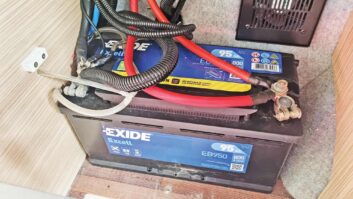Touring during the winter months can be a highly enjoyable experience, with the quieter months providing a great chance to enjoy more peaceful sites and the beautiful views of the season. However, a key factor in getting the most from your trip will be ensuring you know how to keep a campervan warm in winter.
Here, we take a look at the heating options and some of the other tips and techniques you can try to keep you warm in your campervan.
Buy a suitable heater
Modern ‘vans that come with a motorhome heating system such as a blown-air system from Truma or Whale, or a wet radiator system from Alde (as seen in the Auto-Sleeper M-Star), should offer you the flexibility of controlling it remotely, thanks to apps such as Truma’s iNet X, Whale’s iVan, and Alde’s Smart Control. This will be particularly useful if you’re heading back to your campervan and want to return to a toasty interior.

However, not every ‘van will come with a heating system fitted, particularly if it’s a self-build campervan – and even if it does, you may not want to sleep with it running if you’re at a campsite with electric hook-up. In such cases, getting the best heater for a campervan will be the first step to achieving a warmer interior.
Diesel heaters are a popular option for ‘van owners, providing effective heating. However, it’s worth noting that these need to be installed carefully and the process is not straightforward.
Gas is another popular type. During the winter months, you will need to use propane instead of butane. This is because propane can turn from a liquid to a gas at temperatures of -42ºC, unlike butane, which can only do it at -2ºC. However, the downside of this type of heater is you need a gas bottle to run it – and we’d recommend having a spare too – as well as a CO detector and ventilation. Just like a diesel heating option, it will also need to be carefully fitted in your ‘van.
The last type we’d recommend is an electric option. These provide you with the most portable and flexible way of warming a campervan, as there is no need to have it retrofitted. They also have the benefit of generally being safe, cheap and efficient. They are available as either oil-filled or pure electric, and both have advantages and disadvantages. Oil-filled options are less likely to dry the air out as much and should also operate more quietly. However they have the downside of weighing more than their pure electric counterparts, so are subsequently less portable.
We would also advise making sure you have a good hook-up supply.
While 12V electric options can be purchased, we wouldn’t recommend one as we don’t think they would provide enough heat for a campervan to be worth the cost.
Drop the pop-top
For those who have a ‘van pop-top roof, such as the Panama P57, a quick win could be to drop it overnight when the weather outside is likely to be at its coldest.

Insulate where appropriate
Something else we would recommend is insulating the flood underneath the sofas – if you have a fixed bed, you can do the same here too. Carpet or insulation material will help you do this. Adding lagging to the gas-locker bulkheads could be another helpful tip. Just ensure you don’t block the drop-out vents in the floor, as these are crucial for allowing propane and butane to escape, should a leak occur.
You could also think about insulating your motorhome’s wheel arches – it’s something that can help to make your ‘van a bit more energy efficient and provide a barrier against the colder weather.
The cab area is also likely to be where heat is mainly lost at night – a workaround could be changing to a thermal external screen if you only have standard blinds. Drawing a curtain around the cab can also play a part in helping to improve the warmth of your ‘van.
The benefits of having an awning during the winter
The best motorhome awning doesn’t just come in useful during the summer months. Having a drive-away awning can be a very useful accessory to have for a winter tour – they essentially create an ‘airlock’, giving you a space where you can take off any wet gear of muddy boots without letting too much hot air escape. We’d advise opting for a sturdy air or pole awning, but do ensure it’s securely pegged down.
Make sure you’ve packed accordingly
This point is more to help you keep warm in the campervan than something you can do to heat the interior, but also highlights the importance of packing the right accessories. We’d advise taking your warmest clothing (not overlooking some thick socks!), as well as an appropriate winter duvet and a hot water bottle.
If, after your tour, you’ve decided the time has come to store your ‘van for the season, don’t miss our tips to winterising a motorhome to ensure it’s ready for storage.
Lead image: Getty Images
Future Publishing Limited, the publisher of Practical Motorhome, provides the information in this article in good faith and makes no representation as to its completeness or accuracy. Individuals carrying out the instructions do so at their own risk and must exercise their independent judgement in determining the appropriateness of the advice to their circumstances. Individuals should take appropriate safety precautions and be aware of the risk of electrocution when dealing with electrical products. To the fullest extent permitted by law, neither Future nor its employees or agents shall have any liability in connection with the use of this information. Double check any warranty is not affected before proceeding.
If you’ve enjoyed reading this article, why not get the latest news, reviews and features delivered direct to your door or inbox every month. Take advantage of our brilliant Practical Motorhome magazine SUBSCRIBERS’ OFFER and SIGN UP TO OUR NEWSLETTER for regular weekly updates on all things motorhome related.









